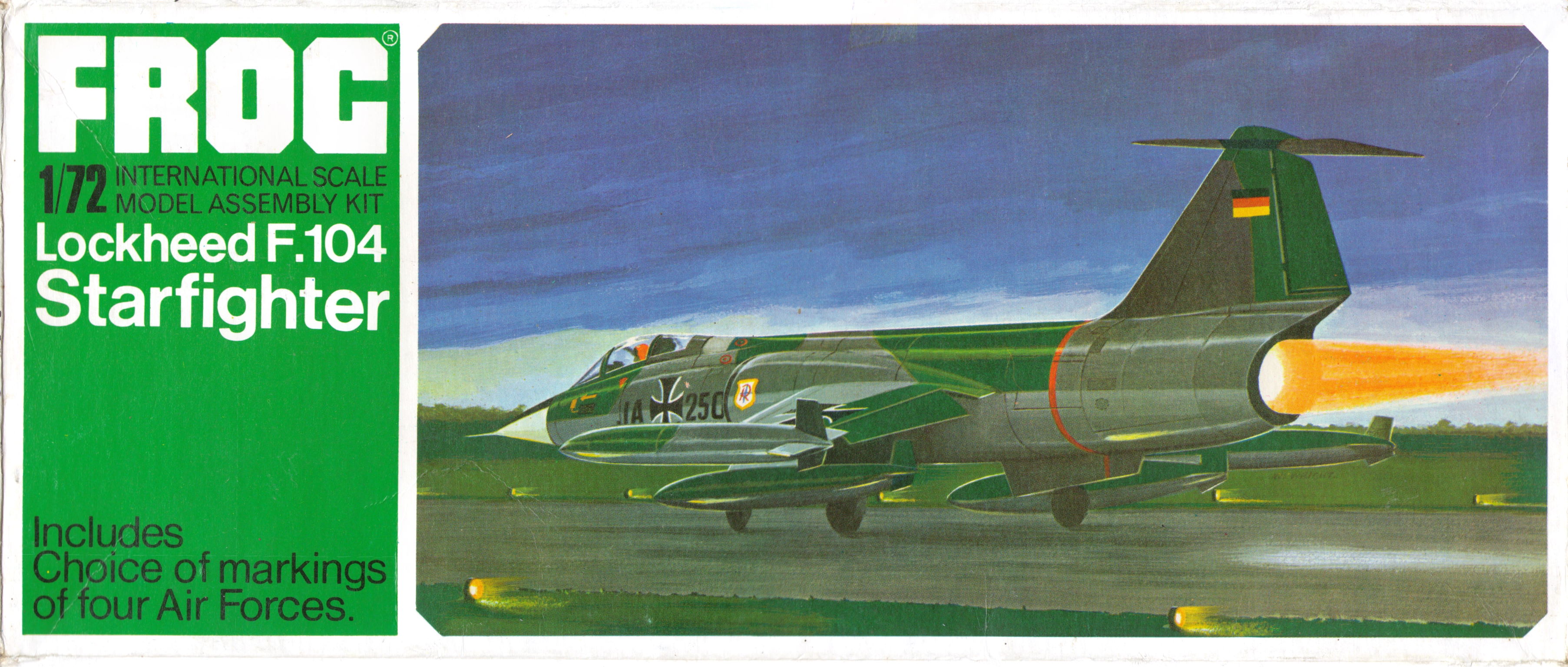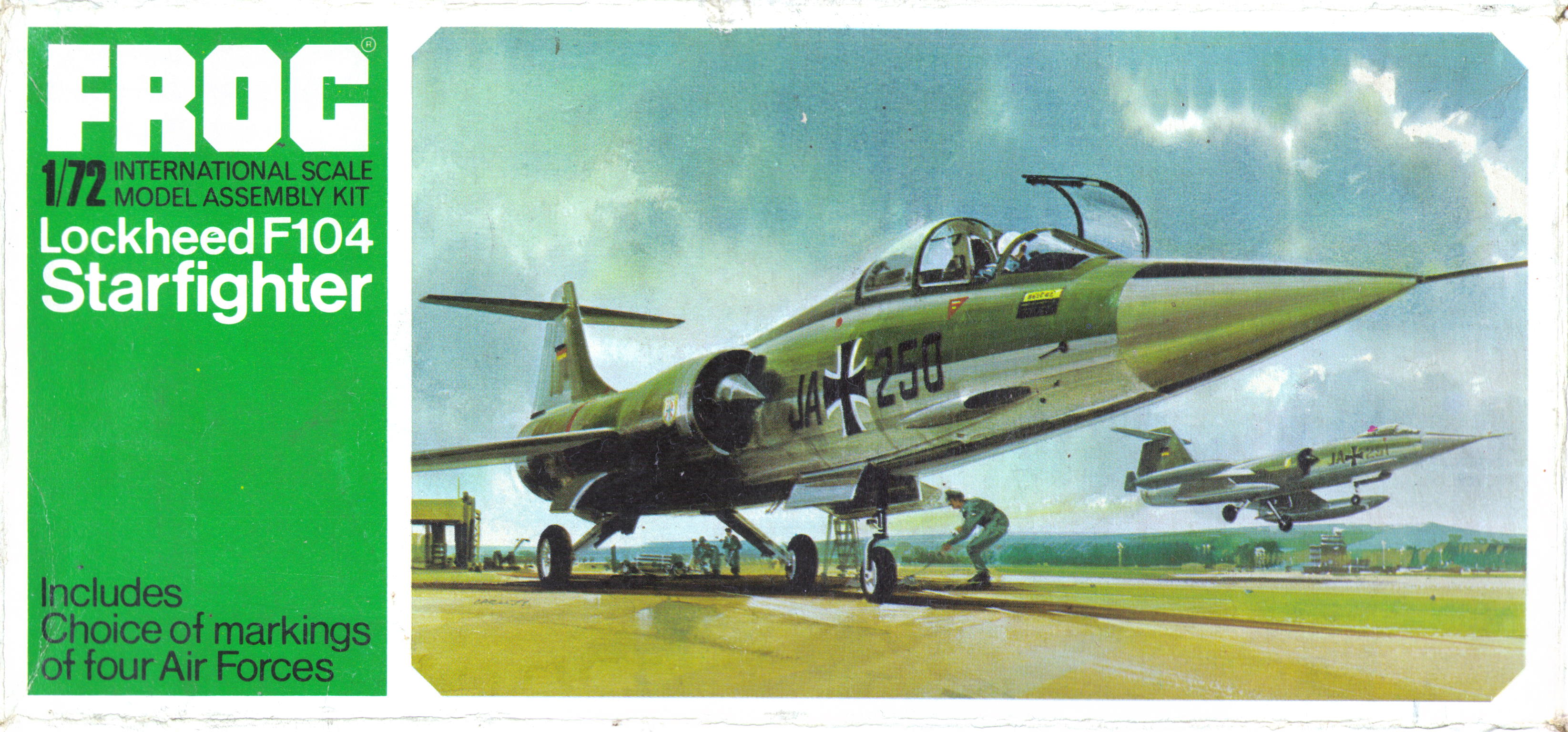ЭНТУЗИАСТ МОДЕЛИЗМА
Еще один Starfighter
Знаменитый или печально известный истребитель F-104 Starfighter компании Lockheed уже появлялся в масштабе 1/72 от Airfix, Hasegawa/Frog и Lesney на протяжении многих лет, и можно считать, что эта тема получила должное внимание. Heller, очевидно, считает иначе, и его набор Starfighter, по крайней мере, достаточно превосходит своих предшественников, чтобы сделать его появление желанным. Состоящий из 58 деталей, некоторые из которых являются альтернативными и позволяют построить либо одноместный F-104G, либо двухместный TF-104G, набор предлагает отделку и детализацию очень высокого уровня. Имеются две носовые секции фюзеляжа с деталями для одноместной или двухместной кабин, а линия стыка с хвостовой частью расположена таким образом, чтобы избежать каких-либо неприглядных щелей. Кабины хорошо оборудованы, а фонари исключительно четкие с хорошо выраженным каркасом.
Четкие посадочные фары являются особенностью, а шасси имеет полный набор подкосов с хорошо сформированными створками масштабной толщины. Воздушные тормоза в кормовой части фюзеляжа могут быть зафиксированы в выдвинутом или убранном положении и включают в себя тяги. Острые кромки и бритвенно-тонкие секции крыльев и хвостового оперения выглядят очень хорошо, также предусмотрены четыре сбрасываемых бака: два для установки на законцовках крыльев, а остальные - на подкрыльевых пилонах. К сожалению, лист декалей не соответствует тем же стандартам, что и остальная часть набора: он полностью матовый и страдает от недостатка цветовой четкости, но он, безусловно, обширен и охватывает не менее пяти различных самолетов - бельгийских и датских двухместных, а также голландских, федеральных немецких и канадских одноместных - для которых цветовые схемы довольно подробно приведены на обороте листа инструкции.
Ф. ДЖ. ХЕНДЕРСОН
Air Enthusiast 1976-11 vol.11 no.05
KIT COMMENT
TWO-IN-ONE KIT FROM HELLER
SINGLE AND TWO-SEAT F-104 PRODUCED
BECAUSE of the popularity of certain aircraft with the enthusiast it becomes so well known and the minutest subtlety of shape understood that when a new plastic construction kit of that type comes on the market it suffers immediate criticism for the slightest incorrect detail. Such has been the case of the Lockheed F-104 which up to now has been the nearest thing to a Eurofighter that we have known, as apart from the French and the British, every other NATO country has used it.
In the past six months there have been three models in varying scales issued of this aircraft. These have included the Hasegawa 1:32nd scale example, the Matchbox 1:72nd scale one and now Heller have marketed their kit, again in 1:72nd scale. So far the Hasegawa model has led the field in accuracy and detail but this is to be expected in such a large kit. The Matchbox model was not without its faults so we had much to hope for when we received the Heller example recently.
The first and most gratifying surprise was that not only did the box contain an F-104G but also its two-seat trainer variant the TF-104. Here, we thought was something well worth having as many of us must surely have laboured on making one of the vacuform kits of the longer nose or carved one out of balsa.
Looking further we found five separate sets of decals and surface detail that looked superb. This kit, we thought, must definitely suit the Starfighter nuts but when the construction work was started there were several things in the early stages that tended to change our opinions.
POOR FIT
It is always an anti-climax after opening a new kit, being delighted with the contents, the detail on the parts and the variety of decals to run into snags when the construction work begins.
This was the case of the Heller Starfighter as the fuselage construction became something of a headache. We appreciate that Heller had a problem in combining both the single and two-seat aircraft in the same kit as this meant that no less than three fuselage breaks were necessary but to get them to line up proved more difficult than the average modeller would like to tackle.
The biggest problem came in getting the fuselage halves to join properly and a close inspection revealed why. The angle of the two fuselage walls where the joint had to be made was not at right angles meaning that, although locating pins and holes were provided, these did not fit one with the other. This, we thought, was a very basic mistake considering the superb care and attention that had been paid to surface detail elsewhere in the kit.
The only answer was to fit the parts together as best we could and then apply body putty to the joint in order to fill the inevitable gap. In some cases we cut off the locating pin heads as these impeded the join rather than assisting it.
Choosing to make the two-seat TF-104 we found that the nose section was divided vertically whereas the centre section and wings were split horizontally. The rear part of the fuselage, again with a vertical joint, fitted over the top of the wing section and the undercarriage well was added on the underside. There were no less than six joints to make in the fuselage alone all of which had to be filled and rubbed down which naturally took time.
The cockpit detail was excellent, measuring up to anything that Airfix has been producing recently. By careful-painting it approached the excellence of the Hasewaga 1:32nd scale model, which was all to the good as the canopy was a very clear one and all the detail could easily be seen. One slightly annoying point was that no locating pins were provided for the seats and one had to make a guess as to where things fitted into each respective cockpit 'box'. A little careful thought did provide the answers but this again was no job for the novice.
Top marks went to the detailing of the panel lines, the undercarriage which was true to scale and therefore very delicate, and the undercarriage wells themselves which compared in accuracy to their Hasegawa 'big brother'. Four drop tanks are provided, the fuselage air brakes can be fitted in the open position and the extremely careful moulding of the jet orifice was to be commended. Having got over the problems of the construction we felt much better, as when complete the model looked all it should be. It was very difficult to avoid rubbing off some of the surface detail when cleaning up the filler but with small pieces of wet and dry paper and the minimum of rubbing we managed to get away with most of it.
Turning to the painting we had a multiple choice in that Heller have given no less than five colour schemes and sets of markings from which to choose. These included an F-104G of JG33 in the Federal German Air Force, a Belgian two seater from 31 Squadron, 10 Wing, another from the Danish Air Force coded RT-631, a Dutch F-104G from 306 Sqdn. and finally a CF-104 from the CAF's 439 Sqdn. based at Soellingen. Being adventurous we chose the Belgian two-seater as this meant the three-tone camouflage scheme on the upper surfaces had to be painted and required the minimum use of decals to finish it off.
When complete the model looks very satisfactory and the paint hid all our efforts at filling the joints. Perhaps the canopy could have been a slightly better fit and possibly the nose probe was slightly overscale but these details did not detract from what was obviously an accurate kit overall.
The Heller Starfighter will, we think, become the experts model where accuracy rather than ease of construction is concerned. It is no model for the newcomer to the hobby and at £1,30 will also restrict the sale to all but the real enthusiast.
Aviation News Vol 5 Num 5 6-19 August 1976
|




















